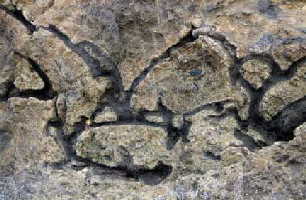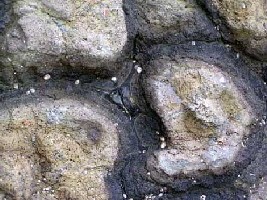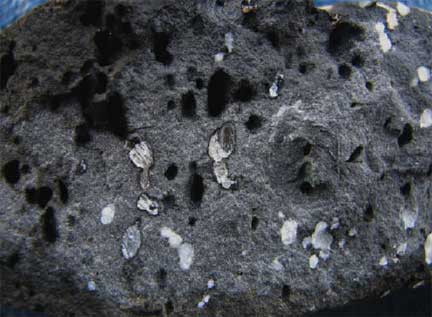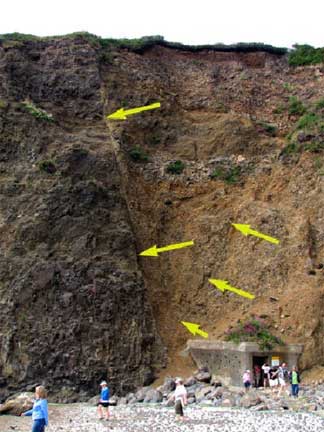|
 |
 |
|
Zeolites of Oceanside
|
 |
 |
|
ERIONITE and ASSOCIATED MINERALS
FROM OCEANSIDE, TILLAMOOK COUNTY, OREGON
by
Rudy W. Tschernich
Curator
Rice Northwest Museum of Rocks and Minerals
|
 |
 |
|
Miocene volcanic rocks that are part of the Columbia River Basalt Group account for most of the spectacular headlands, cliffs, seastacks, and arches found along the northern Oregon coast that extend from Tillamook Head (south of Seaside) in the north to Yaquina Head near Agate Beach in the south.
 |
 
The headlands at Yaquina Head, Cape Lookout, and Cape Meares, including the area near Oceanside, are the remnants of ancient volcanic islands that first flowed from fissures into an ancient sea 16 million years ago to form breccia and pillow lava. They were later covered with massive surface basalt flows and fragmental debris when the islands rose above the sea 14 million years ago. These rocks are equivalent in composition and age to the Grand Rhonde basalt so common in eastern Oregon and Washington and along the Columbia River Gorge. The rock is silica-rich tholeiitic basalt, near andesite in composition, with areas that are full of vesicles (gas bubbles) lined with zeolites, calcite, chalcedony, and clay. Zeolites are a group of about 90 species that are related by structure and chemistry. They normally are composed of a framework of silicon, oxygen, and water with various amounts of calcium, sodium, and potassium. Silica-rich zeolites such as erionite, clinoptilolite, mordenite, and dachiardite along with lower silica zeolites, phillipsite and chabazite, are found on a clay mineral in the vesicles. Colorless quartz variety agate also occurs in some of the vesicles. Erosion of this rock produces most of the agate found on Oregon beaches.
Zeolites were first collected in these rocks at a quarry near Cape Lookout in 1961 by John Cowles. Work in the early 1970’s by the author produced excellent specimens of erionite, dachiardite, clinoptilolite, and other minerals from Cape Lookout and Yaquina Head. At Yaquina Head, one boulder contained spectacular balls of erionite that resembled “fish eggs”. The area at Oceanside was explored at that time but was not extensively worked since it appeared to contain only weathered and stained clinoptilolite, mordenite, and erionite similar to the clean, fresh zeolites found in the quarries at Cape Lookout and Yaquina Head. In the spring of 1995, Aaron Weiting brought to my attention some spectacular green erionite balls similar to those found at Yaquina Head that he had found in boulders on Tunnel Beach and Short Beach. This report deals with the occurrence of the zeolites in the Oceanside area, which includes the beaches and cliffs extending from Oceanside in the south to Cape Meares in the north.
In the north, zeolites are found in rounded beach basalt that has eroded from the nearby cliffs along Short Beach, just south of Cape Meares. To reach the site, proceed from Oceanside, along the Three Capes Road, 1.1 miles to the 3.5-mile post and park at the low point along the road. Short Creek drains a small lake east of the road down to the beach on the west side of the road. Stairs and a trail have been made along the creek that leads from the road to the rocky beach below. If you miss the parking spot, http://mineral.galleries.com/minerals/sulfides/pyrite/pyrite.htm 100 feet north of the creek, Radar Road turns to the west. Further up the road an active barren quarry is located along the road 0.6 miles from the creek. Erionite, clinoptilolite, mordenite, chabazite, phillipsite, chalcedony, and pyrite are found in the beach rock near the base of the trail and around the basalt cliffs to the south. A basalt hill or sea stack just off shore from the base of the trail is filled with colorless chalcedony nodules. Boulders to the far north along the beach nearest Cape Meares contain an abundance of clinoptilolite, mordenite, calcite, and chalcedony.
|
|
|
 |
|
|
 |
|
Inner surface of the vesicular boulder after it was broken.
|
|
 |
 |
|
The best zeolite collecting is in the seacliffs and boulders along the beach north of the tunnel leading though the basalt headland (Maxwell Point) at the town of Oceanside. To reach this area park at the Oceanside Beach State Wayside and walk 1/4 mile north along the beach to the base of the basalt headland. Notice the well exposed pi llow basalt that formed when hot lava flowed in the sea, at the base of the cliff. The best zeolites are found in a flow just above the pillow basalt. At low tide you can walk around the headland, but you must remember that the water can quickly cut you off and the cliffs are too steep to climb. At high tide the water may extend all the way to the base of the cliffs along Tunnel Beach. A 120-foot tunnel was dug through Maxwell Point above the high tide line to allow access and retreat during high tide. Note the red broken basalt bound by to intersecting lines running through the basalt directly above the tunnel. These are faults. Movement along these faults makes the rock unstable and makes a poor place for buildings. I normally use the tunnel to reach the beach and cliffs a couple of hours after high tide. I then do my collecting, trimming, and wrapping of the zeolites and wait for low tide (positive one foot or lower) to pack out the rock. The beach next to Maxwell Point changes daily. At times the sand has been eroded away and a deep water-filled trench is present near the base of the cliff making it impractical to walk around the point unless you have a minus 2 or lower tide. Other times the sand is piled high near the base of the cliff and you can easily walk around even at a (positive one foot) low tide. Check a tide table before collecting in this area. Dragging a full pack of rocks and tools through the tunnel is no fun at all. llow basalt that formed when hot lava flowed in the sea, at the base of the cliff. The best zeolites are found in a flow just above the pillow basalt. At low tide you can walk around the headland, but you must remember that the water can quickly cut you off and the cliffs are too steep to climb. At high tide the water may extend all the way to the base of the cliffs along Tunnel Beach. A 120-foot tunnel was dug through Maxwell Point above the high tide line to allow access and retreat during high tide. Note the red broken basalt bound by to intersecting lines running through the basalt directly above the tunnel. These are faults. Movement along these faults makes the rock unstable and makes a poor place for buildings. I normally use the tunnel to reach the beach and cliffs a couple of hours after high tide. I then do my collecting, trimming, and wrapping of the zeolites and wait for low tide (positive one foot or lower) to pack out the rock. The beach next to Maxwell Point changes daily. At times the sand has been eroded away and a deep water-filled trench is present near the base of the cliff making it impractical to walk around the point unless you have a minus 2 or lower tide. Other times the sand is piled high near the base of the cliff and you can easily walk around even at a (positive one foot) low tide. Check a tide table before collecting in this area. Dragging a full pack of rocks and tools through the tunnel is no fun at all.
Once you reach the beach you can start looking for rounded vesicular
|
Earthquake faults above tunnel in Maxwell Point
|
beach boulders that contain cavities lined with white minerals. Exposed cavities have been sand blasted and any exposed crystals are damaged. A 4 to 6 pound hammer is required to break the rock for it is very hard and brittle. On my first collecting trip to this area I found a 300 lb. boulder partly buried in the sand that showed radiating groups of erionite up to 15 mm across on its surface. I proceeded to break it up and with darkness and high tide approaching, packed out what I could through the tunnel. I left about 50 lb. of broken up rock, which contained nice erionite balls and the remaining large 150 lb. boulder for the next morning when a low minus 2.8 tide would allow me to use the packboard to remove the remaining rock around the cliffs. Arriving at 6:30 am, the next day I quickly made my way to where I had left my treasure. It was gone! Mother Nature had played a dirty trick. Not a trace of the big boulder remained, only a nice thick layer of sand. After some searching I found a few scattered pieces I had broken off the boulder but even one night of rolling in the surf partly rounded the rock and sand blasted any exposed crystals. I learned my lesson. Never leave specimens on the beach. The 150 lb. boulder was never found. It’s the one that got away. The wave action does have its way of cleaning the beach. After a days breaking rock the next tide will remove them making it look as if no one had been there.
The most abundant zeolites are clinoptilolite, mordenite, and erionite while chabazite, dachiardite, and phillipsite are scarce. Pyrite and gyrolite are also present. The minerals crystallized in the order: black clay > pyrite > chalcedony crust and hemispheres > green erionite > white erionite > clinoptilolite-mordenite-clinoptilolite > chalcedony > phillipsite-chabazite > calcite.
A thin colorless crust of chalcedony or scattered, colorless, dull-surfaced hemispheres of chalcedony cover the clay-lined walls in most cavities. In many of the cavities brilliant pyrite cubes can be seen between the clay and the transparent chalcedony crust. Erionite, mordenite, and clinoptilolite are found on the chalcedony. The first zeolite to crystallize is erionite. In its early stages of growth, the erionite formed radiating groups of long colorless prisms or needles that combine into smooth-surfaced, lustrous, compact hemispheres, up to 10 mm across. Many of these erionite hemispheres are filled with clay inclusions that impart very attractive shades of lemon yellow, light yellow-green, dark green, and golden brown color. Following the early compact colored erionite hemisphere phase, erionite formed silky white bundles and radiating fans, up to 15 mm long, either growing on the chalcedony hemispheres or extending the size of the early-formed colored erionite hemispheres. When the colored hemispheres are overgrown with the white generation of erionite, the surface of the aggregate is no longer smooth and lustrous due to different rates of growth for each needle. The irregular surface appears milky or frosted. In some cavities the thin white needles of erionite have used the hemispheres of chalcedony as nucleation sites and formed spikes on the chalcedony balls. Some of the erionite also forms flared bundles of needles that are wider at their termination than at their base. Continued growth of the erionite completely covers the chalcedony. The white erionite needles are silky white when viewed on their sides but are dark when viewed down the end of the group of needles. They resemble bundles of fiber optic filaments. A simple hexagonal prism is not often observed due to the small size of individual needles and irregular twinning of the prisms. The brilliant green balls of erionite hemispheres are particularly attractive when surrounded with the silky white erionite needles.
|
 |
 |
|
After the two phases of erionite growth, mordenite crystallized. It formed tiny short white needles, only 1 or 2 millimeters long, covering the exposed chalcedony crust and chalcedony hemispheres. It also totally encrusts many of the white fan-like groups of erionite but for some unknown reason does not crystallize on the compact smooth-surfaced erionite. Mordenite also forms snow-white aggregates that resemble tiny cotton balls, only a few millimeters across, and usually cover the white erionite needles.
|
 |
 |
|
Colorless to light-green blocky clinoptilolite crystals, up to 3 mm long, often form attractive aggregates, up to 10 mm across, and are commonly associated with small white mounds of mordenite needles. Most of the clinoptilolite crystallized after the mordenite. The color white of the mordenite clearly seen through the colorless clinoptilolite; however, some of the clinoptilolite crystals contain a dark center that indicates it started crystallization before the mordenite.
Colorless rhombohedra of chabazite, up to 8 mm across, are rarely found lining some cavities or covers erionite. Blocky colorless phillipsite crystals, up to 3 mm long, are found on erionite in few cavities. Filiform or octahedral pyrite is very rarely found on the zeolites. A few cavities contain thin, white, micaceous, hexagonal plates and aggregates of gyrolite on the erionite. In addition to the thin crust of chalcedony that predates zeolite crystallization: colorless spheres of chalcedony cover erionite, mordenite, and clinoptilolite completely filling some cavities. Colorless chalcedony commonly fills cavities that do not contain zeolites and when weathered from the basalt this chalcedony becomes the beach agate commonly found in this area.
|
|
|
|

